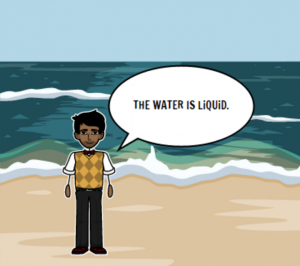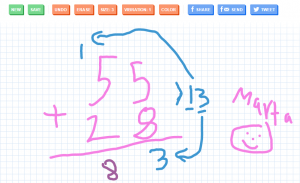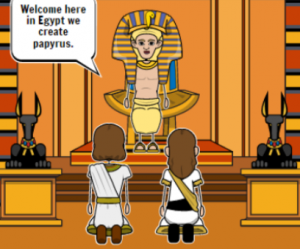2nd Grade Matter Comics
 Second graders at Laburnum Elementary have been learning about the states of matter (SOL2.3), so today students in Ms. MacKenzie’s class created states of matter comics using StoryboardThat. First we reviewed different types of solids, liquids, and gases so everyone wasn’t doing the same ones. I’ve found that students are very creative when it comes to solids, but they need a little help thinking of different liquids and gases. I pointed out that anything that flows is a liquid: lava, honey, ketchup, even applesauce. For gases, we talked about the sun and the gas giants, as well as helium, oxygen, hydrogen, and more. Then we used the three-panel comic on StoryboardThat to illustrate the three types of matter. We clicked and dragged background scenes to each panel, then we added characters. I showed them how to use the “Edit Pose” button to change their poses and facial expressions. Finally we added the speech bubbles (textables) and typed a sentence in each one describing the state of matter shown. We used the snipping tool to take a screenshot of our finished comics and posted them on Google classroom. You can see them all here.
Second graders at Laburnum Elementary have been learning about the states of matter (SOL2.3), so today students in Ms. MacKenzie’s class created states of matter comics using StoryboardThat. First we reviewed different types of solids, liquids, and gases so everyone wasn’t doing the same ones. I’ve found that students are very creative when it comes to solids, but they need a little help thinking of different liquids and gases. I pointed out that anything that flows is a liquid: lava, honey, ketchup, even applesauce. For gases, we talked about the sun and the gas giants, as well as helium, oxygen, hydrogen, and more. Then we used the three-panel comic on StoryboardThat to illustrate the three types of matter. We clicked and dragged background scenes to each panel, then we added characters. I showed them how to use the “Edit Pose” button to change their poses and facial expressions. Finally we added the speech bubbles (textables) and typed a sentence in each one describing the state of matter shown. We used the snipping tool to take a screenshot of our finished comics and posted them on Google classroom. You can see them all here.









